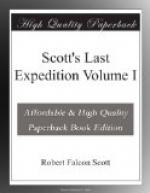I learned this fact only a few days ago and had quite given up the hope of ever seeing the poor little beast again. It is extraordinary to realise that this poor, lame, half-clad animal has lived for a whole month by himself. He had blood on his mouth when found, implying the capture of a seal, but how he managed to kill it and then get through its skin is beyond comprehension. Hunger drives hard.
Wednesday, June 14.—Storms are giving us little rest. We found a thin stratus over the sky this morning, foreboding ill. The wind came, as usual with a rush, just after lunch. At first there was much drift—now the drift has gone but the gusts run up to 65 m.p.h.
Had a comfortless stroll around the hut; how rapidly things change when one thinks of the delights of yesterday! Paid a visit to Wright’s ice cave; the pendulum is installed and will soon be ready for observation. Wright anticipates the possibility of difficulty with ice crystals on the agate planes.
He tells me that he has seen some remarkably interesting examples of the growth of ice crystals on the walls of the cave and has observed the same unaccountable confusion of the size of grains in the ice, showing how little history can be gathered from the structure of ice.
This evening Nelson gave us his second biological lecture, starting with a brief reference to the scientific classification of the organism into Kingdom, Phylum, Group, Class, Order, Genus, Species; he stated the justification of a biologist in such an expedition, as being ’To determine the condition under which organic substances exist in the sea.’
He proceeded to draw divisions between the bottom organisms without power of motion, benthon, the nekton motile life in mid-water, and the plankton or floating life. Then he led very prettily on to the importance of the tiny vegetable organisms as the basis of all life.
In the killer whale may be found a seal, in the seal a fish, in the fish a smaller fish, in the smaller fish a copepod, and in the copepod a diatom. If this be regular feeding throughout, the diatom or vegetable is essentially the base of all.
Light is the essential of vegetable growth or metabolism, and light quickly vanishes in depth of water, so that all ocean life must ultimately depend on the phyto-plankton. To discover the conditions of this life is therefore to go to the root of matters.
At this point came an interlude—descriptive of the various biological implements in use in the ship and on shore. The otter trawl, the Agassiz trawl, the ‘D’ net, and the ordinary dredger.
A word or two on the using of ‘D’ nets and then explanation of sieves for classifying the bottom, its nature causing variation in the organisms living on it.
From this he took us amongst the tow-nets with their beautiful silk fabrics, meshes running 180 to the inch and materials costing 2 guineas the yard—to the German tow-nets for quantitative measurements, the object of the latter and its doubtful accuracy, young fish trawls.




